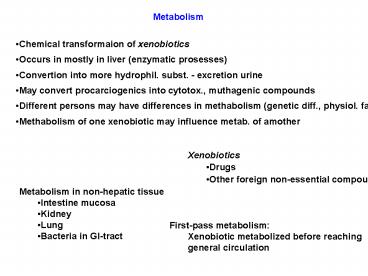Metabolism PowerPoint PPT Presentation
1 / 20
Title: Metabolism
1
Metabolism
- Chemical transformaion of xenobiotics
- Occurs in mostly in liver (enzymatic prosesses)
- Convertion into more hydrophil. subst. -
excretion urine - May convert procarciogenics into cytotox.,
muthagenic compounds - Different persons may have differences in
methabolism (genetic diff., physiol. factors) - Methabolism of one xenobiotic may influence
metab. of amother
- Xenobiotics
- Drugs
- Other foreign non-essential compounds
- Metabolism in non-hepatic tissue
- Intestine mucosa
- Kidney
- Lung
- Bacteria in GI-tract
First-pass metabolism Xenobiotic metabolized
before reaching general circulation
2
First-pass metabolism Xenobiotic metabolized
before reaching general circulation
- Metab. lungs (inhaled subst)
- Intesctine mucosa, GI bacteria
- B)
3
Pathways of metabolism Phase 1
Biotransformation Attachment of new functional
groups, transformation of exist. funct.
groups oxidation, reduction, hydroxylation,
hydrolysis etc. Phase 2 Conjugation. Masking of
an exist. funct. group by for instance
acetylation, glycosylation, attachment amino
acid etc
More hydrophilic drug
Renal excretion
4
Phase 1 Metabolism by cytochrome P450 enzyme
systhem (CYP450)
- Located in endoplasmatic reticulum (liver and
other cells) - Electron transport systhem - oxidation,
monooxygenase - Heme protein flavoprotein
- Capablee of oxidation - many differen xenobiotics
CHEMICAL REVIEWS Volume 104, Issue 9 (September
8, 2004) 3947-3980 Mechanism of Oxidation
Reactions Catalyzed by Cytochrome P450
Enzymes Bernard Meunier, Samuël P. de Visser, and
Sason Shaik lthttp//dx.doi.org/10.1021/cr020443ggth
ttp//dx.doi.org/10.1021/cr020443g
5
(No Transcript)
6
CYP450 families and sub-families
Family 1 CYP1A1 Aromatic hydrocarbon
hydroxylase, metabol. PAH etc.
CYP1A2 Ox of arylamines, nitrosamines, aromatic
hydrocarbons
Family 2 CYP2A6 CYP2B6 CYP2C CYP2D6 Often
enantioselective, lipophil. amines CYP2E1
Halogenated hydrocarbons, other org solvents
Family 3 CYP3A4
7
CYP450 / Mechanisms of metobolic transformations
Hydroxylation of alkane Dehydrogenation of alkane
8
Proposed mech. ox of alkenes
alkynes
9
Proposed mech. ox of aromatics
10
Proposed mech. react. on heteroatom cont.
compounds
N, O, S dealkylation cleav. of small alkylgroups
(Me) Dehalogenation HX carbonyl comp.
11
Proposed mech. react. on heteroatom cont.
compounds
sulfide ox, see FMO
12
CYP450 Induction / inhibition by xenobiotics
- Xenobiotics may enhance metabol. of them selvs as
well as other comp. taken at the same time - Induce transcript CYP450 mRNA - Synth. CYP450
enzymes (enzyme induction) - Drugs
- Ethanol
- Organic solvents
- Components in cig. smoke
St. Johns Worth (Johannesurt, prikkperikum)
13
CYP450 Inhibitors Reversible CYP enzyme
inhibitors Several drugs ex. antimycotic
azoles
14
CYP450 Inhibitors Complexation inhibitors ex.
metabolites from alkylamines
Mechanism based inhibitors (suicide inhib) ex.
alkynes
15
Phase 1 react. not involving CYP450
Other microsomal enzymes Azoreductase Nitrored
uctase Flavinmonooxygenase-FMO (N and
S-ox.) Peroxidases
microsome Artefactual spherical particle, not
present in the living cell, derived from pieces
of the endoplasmic reticulum present in
homogenates of tissues or cells microsomes
sediment from such homogenates when centrifuged
at 100 000 g and higher the microsomal fraction
obtained in this way is often used as a source of
mono-oxygenase enzymes.
16
Flavinmonooxygenase-FMO Cont. FAD
17
Flavinmonooxygenase-FMO
Ox of soft Nu
- Amine ox. to N-oxide / hydroxylamine
- Sulfide ox to sulfoxide , furter to sulfone
- Thiol
18
- Non-microsomal enzymes
- Enzymes in mitokondria
- Enzymes in soubile tissue fractions
19
- Non-microsomal enzymes (Phase 1)
- Molybdenum Hydroxylases
- Aldehyde oxidase
- Xantine oxidase
- Xantine dehydrogenase
Cont. Mo in cat. site Cont FAD and 2 Fe/s
clusters Use H2O not O2
Xanthine oxidase Electron transfer FAD - Fe2S2?I
- Fe2S2?II - Moco - Substrate
Active form
20
- Aldehyde oxidase
- Xantine oxidase
- Xantine dehydrogenase
- (requires NAD)
xanthine oxidoreductase

